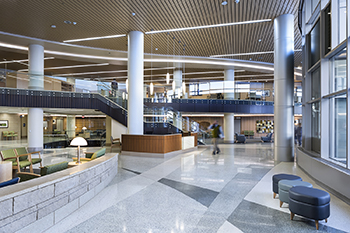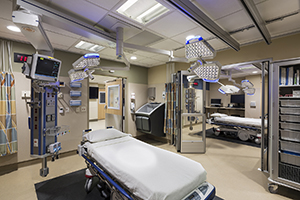Legacy Building Opens Doors for Patients
 LA CROSSE, Wis. — At the forefront of sustainable health care design and building practices, a new $180 million critical care tower recently opened on the Gundersen Health System’s La Crosse campus. The Legacy Building opened for patient care Jan. 19 after nearly three years of construction.
LA CROSSE, Wis. — At the forefront of sustainable health care design and building practices, a new $180 million critical care tower recently opened on the Gundersen Health System’s La Crosse campus. The Legacy Building opened for patient care Jan. 19 after nearly three years of construction.
The 500,000-square-foot building includes a new hospital entrance, lobby, emergency center, imaging center, interventional services, pediatric care and neonatal intensive care unit.
The tower will also be the fifth LEED-certified building for Gundersen, which has been active at incorporating green practices into design and construction.
“I’m proud of the fact that our green principles were incorporated into the Legacy Building; it allows us to continue to provide an exceptional level of care to our patients close to home for generations to come,” said Alan Eber, manager of engineering and energy management with Gundersen Health System, in a statement.
The Legacy Building will be in the top 1 percent energy-efficient hospitals in the region and top 5 percent in the nation, according to designers. AECOM, headquartered in Los Angeles, designed the building, and Minneapolis-headquartered Kraus Anderson Construction served as the construction manager.
“The team knew that sustainability does not come from just spending more, but from making the right decision, which often saves money over time,” said Matt Sanders, AECOM’s lead designer for the project, in a statement. “The best value has to be considered in terms of operational needs, environmental impacts and cost. Balancing these factors requires deeper, more holistic thinking at the beginning. For instance, we selected a substantially higher-performing glass over a less expensive product because we judged the overall value to be superior.”
 Construction crews sorted wastes by metal, wood and concrete. Because of this, approximately 93 percent of construction waste from the project was recycled. Recycled building materials and locally manufactured materials were used whenever possible. The public bathroom counters, concourse ceiling, and carpeting and ceilings throughout the building were constructed with recycled materials, Eber said.
Construction crews sorted wastes by metal, wood and concrete. Because of this, approximately 93 percent of construction waste from the project was recycled. Recycled building materials and locally manufactured materials were used whenever possible. The public bathroom counters, concourse ceiling, and carpeting and ceilings throughout the building were constructed with recycled materials, Eber said.
Ceilings and walls in the building are highly insulated and the large, pressure-tested windows provide connections to the outdoors while ensuring energy efficiency.
A geothermal heat system will move water back and forth from the building to underground wells to bring heat in the winter and remove heat in summer months. Heat will also be extracted from the medical equipment in the building and reused throughout the campus.
 “The largest energy saving component of the building is a geothermal heat pump, which is being used as a heating and cooling source for the building,” Eber said. “Another heating source is our biomass boiler, which uses local wood fuel sources. The biomass boiler replaced aging boilers that were high users of fossil fuels and needed replacement.”
“The largest energy saving component of the building is a geothermal heat pump, which is being used as a heating and cooling source for the building,” Eber said. “Another heating source is our biomass boiler, which uses local wood fuel sources. The biomass boiler replaced aging boilers that were high users of fossil fuels and needed replacement.”
The biomass boiler will also create electricity for the health care campus.
